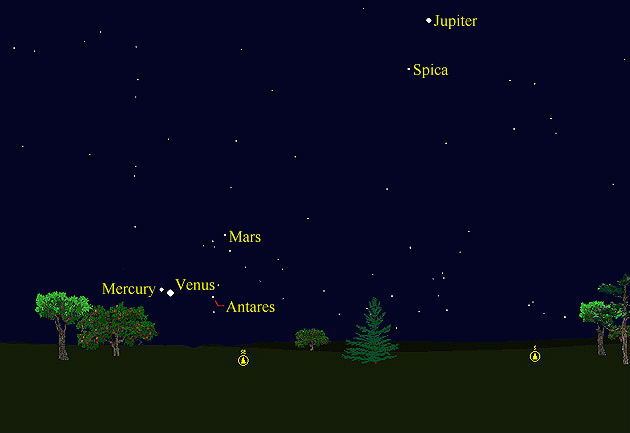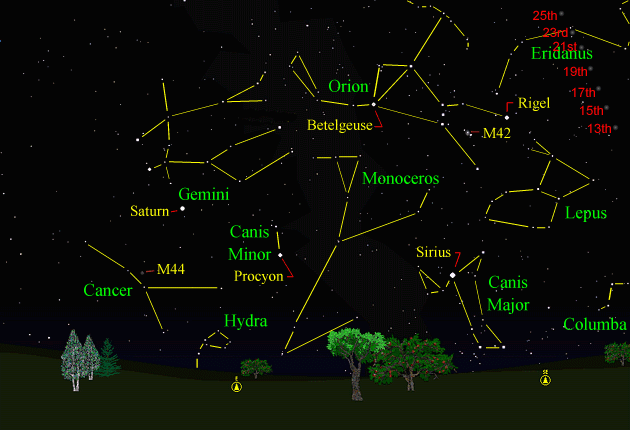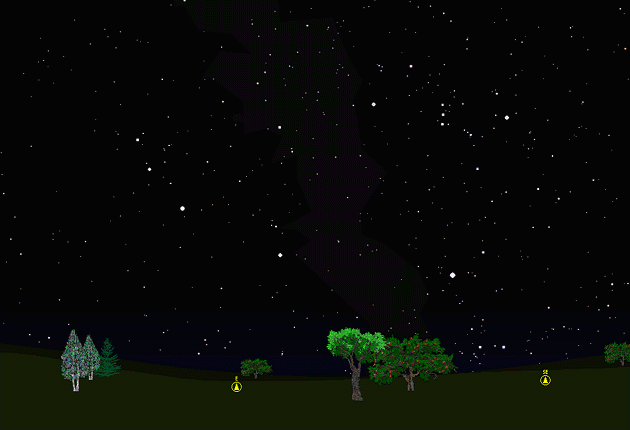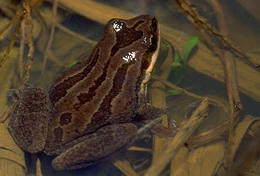The purpose of this new feature is to give scout leaders, educators and naturalists an idea of some of the natural events coming up each month. We will try to cover a variety of natural events ranging from sky events to calling periods of amphibians, bird and mammal watching tips, prominent wildflowers and anything else that comes to mind. We will also note prominent constellations appearing over the eastern horizon at mid-evening each month for our area for those who would like to learn the constellations. If you have suggestions for other types of natural information you would like to see added to this calendar, let us know! We sometimes update the website during the month if something interesting appears. Note: You can click on the hyperlinks to learn more about some of the featured items. To return to the Calendar, hit the "back" button on your browser, not the "back" button on the web page.
Notes and Images From November 2004: We are starting a new section this month with notes and images we've taken during the previous month. We may not always have something to show you, but when we do we'll put them here. An Unexpected Auroral Display: On the evening of November 7th I was testing a new lens setup for my camera. Although it does not say much for my observational awareness, I was so concentrated on the lens that I never saw the auroral display that was high above. After hearing of the display through the media, I went through my images for that night and found this sequence of five images that show an auroral pulse developing in Andromeda. The images are consecutive images made about 20 seconds apart. The digital camera used was a Nikon D-70 with a 24 mm lens. The camera was mounted on a stationary tripod, and the exposures were 10 seconds each at an ISO setting of 1600. The constellation of Perseus is bottom center. Each image will show for 5 seconds, then the next image will appear. Click here to see the show. Venus and Jupiter: This image was taken on the morning of November 6th, one day after the two planets passed within 0.7 degrees of each other. Click here. A Circumzenithal Arc From the Blue Ridge: These images were taken on November 28th, during our bird and amphibian surveys on Cherokee Tribal Lands near Cherokee, N.C. These beautiful arcs are formed when sunlight is refracted through ice crystals high in the atmosphere. They look similar to a rainbow and span about 60 degrees around the zenith (straight up). Always check overhead for these arcs, particularly in the late afternoon, when there are wispy cirrus clouds in the sky. Also, if you ever see bright parhelia on either side of the sun (sundogs), always check overhead. Rarer still is the upper tangential arc to the 22 degree halo, shown in the other image, along with one of the sundogs. Click here. See also our Nature Notes for December 2001. Southern Leopard Frogs: The peak of the Southern Leopard Frog breeding period is in February and March. As fall temperatures drop and mimic the early spring conditions Southern Leopard Frogs call and breed in the fall. We have heard Southern Leopard Frogs calling in September and October in previous years, but this year we've heard them calling at our pond from August through late November. Who knows, they may call into early December!
Sky Events for December: A Comet for the Holidays: Comet Machholz is becoming bright enough to be obvious in binoculars, and can seen with the naked eye if you know where to look. Dates and positions for the rest of December are shown in red on the constellation map below. The comet is shown at 0 hours Universal Time on each date, which corresponds to early evening CST on the day prior. For example, you would go out on the evening of December 14th to look for the comet in the position shown on the chart for the 15th. The best views will be away from city lights, without the moon present, around 10:30pm CST, when the comet's position is due south and it is highest in the sky. It should be fun to watch it slowly drift through Eridanus and into Taurus and Perseus, passing by the Pleiades on the way. The positions are plotted through December 25th. For a more complete look at the comet's path, you can visit the Sky and Telescope website at: http://skyandtelescope.com/observing/objects/comets/article_1396_1.asp The Geminid Meteor Shower peaks on the evening of December 13th and the morning of December 14th. With no interference from the moon, this may be one of the best showers this year. The meteors will appear to radiate from the constellation of Gemini (see Constellations). The Winter Solstice: The winter solstice, corresponding with the shortest day of the year and the beginning of winter for the northern hemisphere, occurs at 6:42am CST on December 21st. At this time, the northern hemisphere of the earth is tilted away from the sun the maximum amount possible. If these early sunsets are getting you down, you can take solace in the fact that the situation improves after December 5th. Because of the tilt of the earth’s axis relative to the plane of its orbit, the earliest sunset and the latest sunrise do not correspond with the shortest day of the year, which occurs on the 21st. The earliest sunset for our latitude this year occurs on December 5th, a little over two weeks before the solstice. The latest sunrise occurs on January 6th, a little over two weeks after the solstice. Evening Sky: For those who are willing to deal with the chilly temperatures, the sky holds some spectacular sights this December. Saturn is truly magnificent this month and at mid-month rises at around 7:00pm. The rings are stunningly beautiful even in a small telescope. Now might be the time to dust off that old telescope in the attic. Look for the thin black division in the rings called Cassini’s division, discovered in 1675. Morning Sky: Occultation of Jupiter: In the early morning hours of December 7th, the waning crescent moon will occult Jupiter. The moon will only be about 10 degrees above the horizon when the occultation takes place. The outermost of Jupiter's four bright moons, Callisto, will disappear around 2:30am CST. Ganymede will wink out of view next around 2:48am CST. Jupiter will be occulted around 2:52am CST, and finally Europa will be occulted around 2:53am CST. Reappearances are as follows (times are approximate): Callisto, 3:38am CST, Ganymede, 3:47am CST, Jupiter, 3:52am CST, and Europa, 3:54am CST. The other bright moon of Jupiter, Io, is behind Jupiter during this time period. As a bonus for getting up this early, the area of Mare Oriental is tipped toward us on this date, allowing a better view of this area.
Starting around December 15th and continuing for about a month, all 5 naked eye planets can be viewed in the sky at dawn. The view below shows the view on December 27th at 6:00am CST. The view below shows all the planets but Saturn. Saturn can be found at this date and time 26 degrees above the western horizon near the waning gibbous moon. Compare Mars (magnitude 1.6) with the star Antares (magnitude 1.0, a little brighter), whose name means, "Rival of Mars".
All times noted in the Sky Events are for Franklin, Tennessee and are Central Standard Time. These times should be pretty close anywhere in the mid-state area. Constellations: The views below show the sky looking east at 9:00pm CST on December 15th. The first view has the constellation outlines and names depicted. Star and planet names are in yellow. Constellation names are in green. The second view shows the same view without labels. Saturn shines bright among the stars of Gemini, the Twins, and the bright star Sirius sparkles like a diamond below mighty Orion, the Hunter. Sirius is in Canis Major, the Great Dog, and is the brightest star in the night sky. It is known as the Dog Star. In the late summer, Sirius rises at the same time as the sun. Because of this, the late summer days are known as “the dog days." Compare the bright stars Betelgeuse and Rigel in Orion. Betelgeuse is a red giant and the star Rigel is a very hot, very bright supergiant. Compare the color of the two stars. If you have a telescope, point it to the center of the three "sword" stars below Orion's belt. You will be pointing at the Orion Nebula, M42, one of the most magnificent emission nebulas in the sky. It appears as a small greenish glow in small telescopes. Crouching beneath the feet of Orion, is Lepus, the hare. Below Lepus is Columba, the Dove. The faint constellation Monoceros, the Unicorn, follows Orion over the eastern horizon. Low in the eastern sky below Gemini is Canis Minor, with its bright star Procyon. Procyon means, "before the dog," and refers to the fact that Procyon rises just before the Dog Star, Sirus. Look below Gemini and see if you can spot the faint glow of M44, the "Beehive Cluster." This cluster is located in Cancer, the Crab. Finally, Hydra, the Water Serpent, rears its head just above the eastern horizon.
On Learning the Constellations: We advise learning a few constellations each month, and then following them through the seasons. Once you associate a particular constellation coming over the eastern horizon at a certain time of year, you may start thinking about it like an old friend, looking forward to its arrival each season. The stars in the evening scene above, for instance, will always be in the same place relative to the horizon at the same time and date each December. Of course, the planets do move slowly through the constellations, but with practice you will learn to identify them from their appearance. In particular, learn the brightest stars (like Sirius and Procyon in the above scene), for they will guide you to the fainter stars. Once you can locate the more prominent constellations, you can "branch out" to other constellations around them. It may take you a little while to get a sense of scale, to translate what you see on the computer screen or what you see on the page of a book to what you see in the sky. Look for patterns, like the three stars in a line in Orion's belt. The earth's rotation causes the constellations to appear to move across the sky just as the sun and the moon appear to do. If you go outside earlier than the time shown on the charts, the constellations will be lower to the eastern horizon. If you observe later, they will have climbed higher. As each season progresses, the earth's motion around the sun causes the constellations to appear a little farther towards the west each night for any given time of night. If you want to see where the constellations in the above figures will be on January 15th at 9:00pm CST, you can stay up till 11:00pm CST on the December 15th and get a preview. The westward motion of the constellations is equivalent to two hours per month. For instance, if you want to see what stars will be on your eastern horizon on March 15th at 9:00pm CST (3 months later), you would need to get up at 3:00am CST in the morning on December 15th (3 months times 2 hours/month = 6 hours). A good book to learn the constellations is H. A. Rey's
classic, The Stars, A New Way to See Them. Rey's depictions of the
constellations and witty commentary are terrific. A good general reference book on astronomy is the Peterson
Field Guide, A Field Guide to the Stars and Planets, by Pasachoff.
The book retails for around $14.00. A good beginners software program for learning the night sky
is the Starry Night Beginner program. Visit the Starry Night web site at
www.starrynight.com The program retails for around $30.00 and
contains a wealth of information.
Amphibians:
December really marks the beginning of the breeding season for our Tennessee frogs and toads. We have had breeding choruses of Upland Chorus Frogs as early as December 4th. Breeding even before Wood Frogs, these irrepressible inhabitants of flooded winter fields and other wet areas will call throughout the cold winter months. Listen for their call, which sounds like someone dragging their thumb across the teeth of a plastic comb, on mild wet winter evenings. Listen also for Southern Leopard Frogs. It's been an odd type of fall, and we've heard them calling in August, September, October and late November this year. Many other Tennessee frogs and toads can also be seen on mild December nights, but most are silent.
Birds: If you walk grassy fields that have some wetter areas, you may flush a Short-Eared Owl, a winter resident in Tennessee. We have flushed them from fields at Pardue’s Pond near Ashland City, along the roads that go to Pace Point near Big Sandy, Tennessee, at Britton Ford near Dover, Tennessee and at Savannah Bottoms, south of Savannah, Tennessee. These birds tend to occupy the same habitat as Northern Harriers, so if you see Harriers over grassy fields, be on the lookout for the owls. They often begin flying in the late afternoon, coursing over the fields like a Harrier. It’s a good idea to check any “Northern Harrier” you see in the late afternoon to make sure it’s not a Short-eared Owl. Through the end of December, listen for the courtship dueting of Great Horned Owls at dusk and dawn. You probably have already put out your bird feeders, but if you haven’t you're missing out on a lot of good looks at winter feeder birds. This is a great time of year to start learning your birds. Watch and listen for winter residents such as White-throated and White-crowned Sparrows, Yellow-bellied Sapsuckers, Red-breasted Nuthatches, Golden-crowned Kinglets and Brown Creepers. Recommended: Bird Finding in Tennessee, Michael Lee Bierly. A classic guide to finding birds in Tennessee. The Sibley Guide to Birds, David Allen Sibley The Sibley Guide to Birds of Eastern North America, David Allen Sibley This new Sibley Guide covers only eastern North America, is quite compact, and is less expensive than the larger Sibley. An inexpensive guide for beginners is the Golden Guide for Birds.
Archives (Remember to use the back button on your browser, NOT the
back button on the web page!)
Natural Calendar
November 2004
Natural Calendar
September 2004
Natural Calendar
February 2004
Natural Calendar
December 2003
Natural Calendar
November 2003
Natural Calendar
September 2003
Natural Calendar
February 2003
Natural Calendar
December 2002
Natural Calendar
November 2002 Nature Notes Archives: Nature Notes was a page we published in 2001 and 2002 containing our observations about everything from the northern lights display of November 2001 to frog and salamander egg masses. Night scenes prepared with Starry Night Pro software All photographs Ó2004 LEAPS
|
||||||||||



